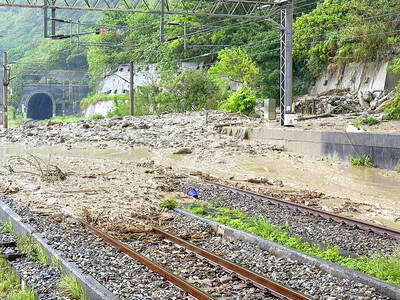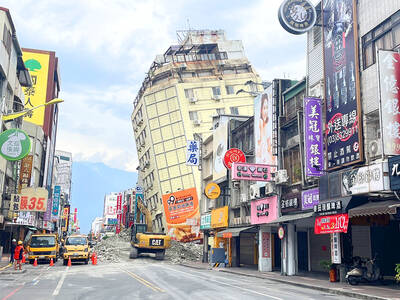While the US has been tied up fighting the war in Iraq, China has made huge gains toward modernizing its military and improving its equipment, and its air defenses are now nearly impenetrable to all but the newest of US fighters, the senior US military official in Japan said.
Lieutenant General Bruce Wright, commander of the roughly 50,000 US forces in Japan, Washington's biggest ally in Asia, said in an interview this week the Iraq War is reducing the availability of US troops and equipment to meet other contingencies and eating up funds that might be used to replace or upgrade planes that are being pushed to their operational limits.
China, meanwhile, is filling the skies with newer, Russian-made Sukhoi Su-27 "Flankers" and Su-30s, along with the domestically built J-10, a state-of-the-art fighter that Beijing just rolled out in January.
China has also improved its ballistic missile defenses and its ability to take the fight into space -- as it proved by shooting down an old weather satellite at an orbital height similar to that used by the US military.
Wright stressed he is "positive" about the current efforts to increase diplomatic and political engagement with Beijing. But he said the Chinese military buildup is disconcerting.
"Are we in trouble? It depends on the scenario," Wright said in the interview on Thursday. "But you have to be concerned about the small number of our forces and the age of our forces."
Wright said the US Air Force's fleet is older than ever.
The average age of the F-15 fighters, for example, is about 24 years, while that of the KC-135 Stratotanker, a mid-air refueling plane that is a key element in the Air Force's ability to conduct long-range missions, is 46 years.
Wright, who was at this air base on Japan's southern island of Okinawa to meet with local commanding officers, said the improvement in Chinese air defenses had made China's airspace "difficult if not impossible" to penetrate with the kind of US fighters -- F-15s and F-16s -- now deployed in Japan.
Doing so would require the F-22 or the Joint Strike Fighter, which both have stealth capabilities. The Air Force sent a dozen F-22s to Japan earlier this year, but only for a temporary deployment. It has no plans to send more there permanently.
The Joint Strike Fighter, or F-35, is not yet combat-ready.
"Our planes are much older than the planes they would be matched against," Wright said. "For the first time in history, we are seeing another nation, in this case China, with newer fighters than we have. We know that they continue to invest at a level that is unprecedented. We need to be watchful of Chinese military capabilities."
He said the demands of supporting ground troops in Iraq has pushed the Air Force to draw on its fighters from virtually anywhere they can be found. Two US F-16 fighter squadrons from the base in Misawa, Japan, are rotating in and out of Iraq.
"The question is how much more are they going to need," he said. "They are already pulling them out of Misawa, so where else are they going to come from?"
Wright said Beijing is also at an advantage because it is not at war.
Also see story:
Taiwan developing long-range missiles: analysts

ROLLER-COASTER RIDE: More than five earthquakes ranging from magnitude 4.4 to 5.5 on the Richter scale shook eastern Taiwan in rapid succession yesterday afternoon Back-to-back weather fronts are forecast to hit Taiwan this week, resulting in rain across the nation in the coming days, the Central Weather Administration said yesterday, as it also warned residents in mountainous regions to be wary of landslides and rockfalls. As the first front approached, sporadic rainfall began in central and northern parts of Taiwan yesterday, the agency said, adding that rain is forecast to intensify in those regions today, while brief showers would also affect other parts of the nation. A second weather system is forecast to arrive on Thursday, bringing additional rain to the whole nation until Sunday, it

CONDITIONAL: The PRC imposes secret requirements that the funding it provides cannot be spent in states with diplomatic relations with Taiwan, Emma Reilly said China has been bribing UN officials to obtain “special benefits” and to block funding from countries that have diplomatic ties with Taiwan, a former UN employee told the British House of Commons on Tuesday. At a House of Commons Foreign Affairs Committee hearing into “international relations within the multilateral system,” former Office of the UN High Commissioner for Human Rights (OHCHR) employee Emma Reilly said in a written statement that “Beijing paid bribes to the two successive Presidents of the [UN] General Assembly” during the two-year negotiation of the Sustainable Development Goals. Another way China exercises influence within the UN Secretariat is

LANDSLIDES POSSIBLE: The agency advised the public to avoid visiting mountainous regions due to more expected aftershocks and rainfall from a series of weather fronts A series of earthquakes over the past few days were likely aftershocks of the April 3 earthquake in Hualien County, with further aftershocks to be expected for up to a year, the Central Weather Administration (CWA) said yesterday. Based on the nation’s experience after the quake on Sept. 21, 1999, more aftershocks are possible over the next six months to a year, the agency said. A total of 103 earthquakes of magnitude 4 on the local magnitude scale or higher hit Hualien County from 5:08pm on Monday to 10:27am yesterday, with 27 of them exceeding magnitude 5. They included two, of magnitude

Taiwan’s first drag queen to compete on the internationally acclaimed RuPaul’s Drag Race, Nymphia Wind (妮妃雅), was on Friday crowned the “Next Drag Superstar.” Dressed in a sparkling banana dress, Nymphia Wind swept onto the stage for the final, and stole the show. “Taiwan this is for you,” she said right after show host RuPaul announced her as the winner. “To those who feel like they don’t belong, just remember to live fearlessly and to live their truth,” she said on stage. One of the frontrunners for the past 15 episodes, the 28-year-old breezed through to the final after weeks of showcasing her unique